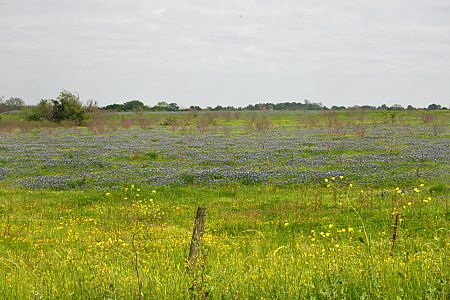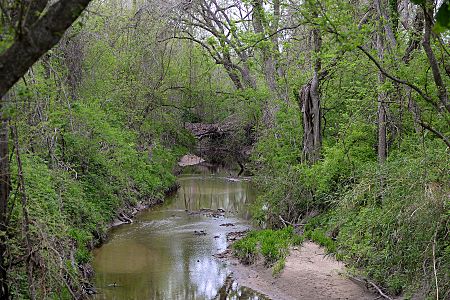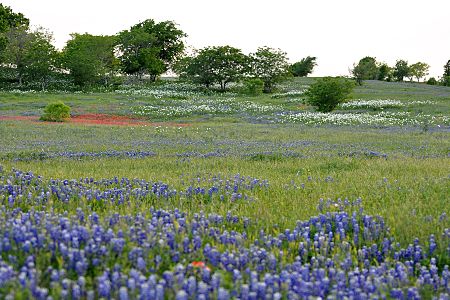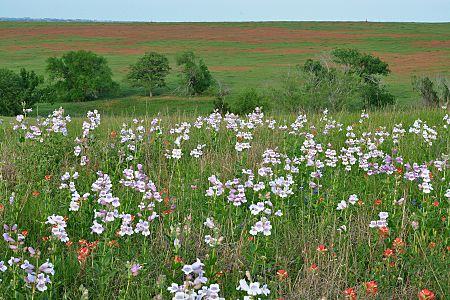Texas Blackland Prairies facts for kids
Quick facts for kids Texas Blackland Prairies |
|
|---|---|
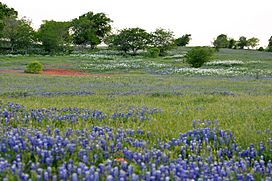
Ranch in Lavaca County, Texas
|
|
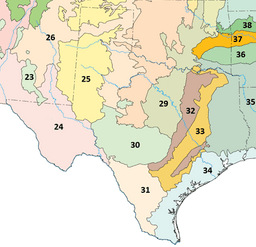
Texas blackland prairies (area 32 on the map)
|
|
| Ecology | |
| Realm | Nearctic |
| Biome | Temperate grasslands, savannas, and shrublands |
| Borders | East Central Texas forests (area 33 on the map), Edwards Plateau (area 30 on the map) and Cross Timbers (area 29 on the map) |
| Bird species | 216 |
| Mammal species | 61 |
| Geography | |
| Area | 50,300 km2 (19,400 sq mi) |
| Country | United States |
| State | Texas |
| Conservation | |
| Habitat loss | 76.458% |
| Protected | 0.64% |
The Texas Blackland Prairies are a special natural area in Texas. It's a type of grassland that stretches about 300 miles (480 km) from the Red River in North Texas all the way south to San Antonio. This area gets its name from its super rich, dark soil, which is great for growing things!
Contents
What is the Texas Blackland Prairies?
This ecoregion covers a huge area, about 50,300 square kilometers (19,400 sq mi). Most of it is one big main belt of land. There are also two smaller areas, like islands, of tallgrass prairie grasslands to the southeast. Both the main part and these "islands" stretch from northeast to southwest.
The main part of the Blackland Prairies has lots of oak trees and open grasslands called savannas. It goes from just south of the Red River (which is on the border with Oklahoma) through the big Dallas–Fort Worth area and into southwestern Texas. Other natural areas border it, like the Central forest–grasslands transition to the north and northwest.
The two smaller "islands" of prairie are the Fayette Prairie (which is about 17,000 square kilometers or 6,600 sq mi) and the San Antonio Prairie (about 7,000 square kilometers or 2,700 sq mi). These two smaller prairies are separated from the main area by oak forests called the East Central Texas forests.
How the Prairie Was Formed
This amazing prairie was shaped over many, many years by two main things: frequent wildfires and visits from huge herds of plains bison.
The Role of Fire and Bison
Imagine big fires, started by lightning, sweeping across the land. These fires helped clear out shrubs and made room for beautiful forbs (flowering plants) and grasses to grow.
Then came the bison! These large animals grazed on the grasses, keeping them trimmed. They also trampled the soil, which helped it stay healthy, and their waste fertilized the ground. All of this helped the tallgrass ecosystem grow strong.
People and the Prairie
For over 15,000 years, hunter-gatherers lived in this area. They also helped shape the prairie by using controlled burns. They would carefully set small fires to make more land suitable for hunting bison and other animals.
Over time, different groups of people lived here, like the Wichita, Waco, Tonkawa, and Comanche. Eventually, people started farming and ranching on a large scale. This changed the prairie a lot and led to a big loss of its natural habitat.
Protecting the Prairie
The soil and climate in the Blackland Prairie are perfect for growing crops. Because of this, most of the original prairie ecosystem has been turned into farmland. Sadly, less than one percent of the original tallgrass prairie remains today. Some experts even think it's less than 0.5% or even 0.1%! This makes the tallgrass prairie one of the most endangered large ecosystems in North America.
But people are working to protect what's left. Small parts of the prairie are being saved at places like The Nature Conservancy's 800-acre Clymer Meadow Preserve near Celeste, TX.
Plants and Animals of the Prairie
The Blackland Prairies are home to many interesting plants and animals.
Prairie Plants
Some important grasses you'd find here include:
You'd also see a variety of colorful wildflowers, such as:
- Gayfeathers
- Asters
- Maximilian sunflower
- Wild indigos
- Compass plant
Prairie Animals
Today, you might spot animals like:
In the past, much larger animals lived here, including American bison, wolves, and even jaguars. But sadly, hunting and the destruction of their habitat caused them to disappear from the prairie.
The Special Soil
The "blackland" in the prairie's name comes from its unique soil. It's a black or very dark gray, alkaline clay. This soil gets even darker from the char (like charcoal) left behind by wildfires and controlled burns. Locals sometimes call this soil "black gumbo" or "black velvet."
When the weather is dry, deep cracks can form in this clay soil. This can sometimes cause problems for buildings and roads. Farmers also have to manage issues like water washing away soil, a plant disease called cotton root rot, and controlling unwanted brush.
Texas Blackland Prairies Gallery
-
Ranchland in the Blackland Prairie eco-region of Texas with Texas bluebonnets (Lupinus texensis), Washington County, Texas, USA (30 March 2012).
-
Washington-on-the-Brazos State Historic Site, Washington County, Texas, USA (30 March 2012).
-
Texas bluebonnets (Lupinus texensis) in the Blackland Prairie eco-region, Highway 532 east of Gonzales, Gonzales County, Texas, USA (19 April 2014).
-
Fox Glove (Penstemon cobaea) on ranchland in the Blackland Prairie eco-region. County Road 269, Lavaca County, Texas, USA (19 April 2014).


